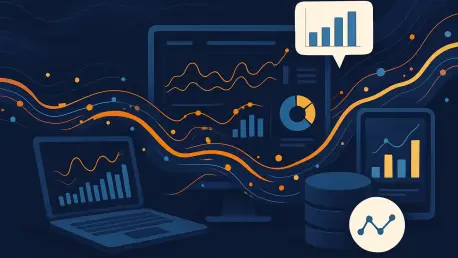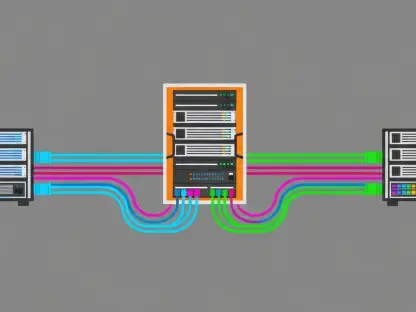In an era where data flows incessantly from countless sources, the ability to process and analyze information in real time is becoming a cornerstone of industrial innovation. Streaming analytics, a technology that enables immediate insights from continuous data streams generated by IoT devices, sensors, and digital platforms, is poised to redefine how businesses operate by the end of this decade. The market for this transformative tool is projected to grow significantly from USD 4.34 billion this year to USD 7.78 billion by 2030, achieving a compound annual growth rate (CAGR) of 12.4%. This rapid expansion underscores a shift toward instantaneous decision-making, allowing industries to respond to challenges and opportunities with unprecedented speed. From detecting fraud in financial transactions to optimizing supply chains in retail, the implications of this technology are vast, promising to enhance efficiency and competitiveness across multiple sectors.
The urgency to harness real-time data is driven by the sheer volume and velocity of information being produced today, and industries are no longer content with delayed insights. They demand tools that can keep pace with live data streams, whether it’s monitoring patient vitals in healthcare or tracking consumer behavior in e-commerce. Streaming analytics offers a solution by processing data as it arrives, eliminating the lag that traditional methods often impose. This capability is proving to be a game-changer in environments where timing is critical, such as autonomous vehicle systems requiring split-second decisions or emergency response scenarios needing immediate action. As this technology evolves, its integration into everyday operations signals a future where responsiveness becomes a defining factor for success.
Market Drivers and Growth Projections
The Power of IoT and Edge Computing
The surge in streaming analytics adoption is closely tied to the explosive growth of the Internet of Things (IoT) and the complementary rise of edge computing. With billions of connected devices—from smart home appliances to industrial sensors—generating continuous data streams, the need for real-time processing has never been more pressing. These streams often contain critical information that must be acted upon instantly, such as a malfunction in a factory machine or a traffic anomaly detected by an autonomous vehicle. Edge computing plays a vital role by processing this data closer to its source, significantly reducing latency and easing the burden on centralized servers. This localized approach ensures that only essential data is transmitted to the cloud, optimizing bandwidth and enabling faster decision-making. By 2030, the synergy between IoT expansion and edge computing is expected to make streaming analytics an integral part of operational frameworks across industries.
Another dimension of this driver is the increasing complexity of applications that rely on immediate data insights. Sectors like industrial automation and smart surveillance depend on streaming analytics to monitor systems in real time, identifying issues before they escalate into costly problems. For instance, edge-enabled analytics can filter out irrelevant data at the source, ensuring that only actionable insights reach decision-makers. This efficiency is particularly crucial in high-stakes environments where even a slight delay can lead to significant consequences. The ongoing proliferation of connected devices, coupled with advancements in edge technology, is setting the stage for a future where streaming analytics becomes indispensable. As industries continue to digitize, the ability to process data at the point of origin will likely become a standard expectation rather than an exception by the end of the decade.
Scalability Through Integrated Platforms
Scalability is a cornerstone of the streaming analytics market’s projected growth from USD 4.34 billion currently to USD 7.78 billion by 2030, driven by the availability of integrated platforms that simplify deployment. These platforms are designed to handle massive data volumes with ease, allowing businesses to scale operations without the constraints of traditional infrastructure. This accessibility means that even smaller enterprises can adopt real-time analytics, tapping into insights that were once the domain of larger corporations with extensive resources. The flexibility of these solutions enables rapid adaptation to changing market conditions, ensuring that organizations remain agile in dynamic environments. As a result, industries ranging from retail to logistics are finding ways to integrate streaming analytics into their workflows, enhancing their ability to respond to customer needs and operational challenges.
Beyond accessibility, integrated platforms are fostering innovation by providing seamless compatibility with other technologies like artificial intelligence (AI) and machine learning (ML). This convergence allows for more sophisticated data processing, such as predictive modeling and automated decision-making, directly within the streaming framework. Businesses can deploy these tools without needing extensive in-house expertise, lowering the barrier to entry and encouraging widespread adoption. Additionally, the cost-effectiveness of scalable platforms reduces the financial burden of maintaining on-premises systems, making real-time analytics a viable option for a broader range of industries. By 2030, the democratization of such technology through integrated solutions is expected to level the competitive playing field, empowering organizations of all sizes to leverage data-driven insights in their strategic planning.
Technological Innovations Shaping the Future
AI and ML as Game-Changers
The integration of artificial intelligence (AI) and machine learning (ML) into streaming analytics platforms is revolutionizing how industries extract value from real-time data. These advanced technologies enable predictive insights, allowing businesses to anticipate trends and issues before they materialize. For instance, in the banking sector, AI-driven analytics can detect fraudulent transactions as they occur, minimizing financial losses. Similarly, retailers use ML algorithms to forecast sudden demand spikes, adjusting inventory in real time to meet customer needs. This predictive capability transforms raw data streams into strategic assets, offering a competitive edge in fast-paced markets. By 2030, the widespread adoption of AI and ML in streaming analytics is expected to redefine decision-making processes across sectors like telecommunications, manufacturing, and beyond.
Moreover, the ability of AI and ML to identify anomalies in data streams is proving invaluable for operational efficiency, especially as industries increasingly rely on data for strategic decisions. In manufacturing, for example, these tools can spot irregularities in production lines instantly, preventing costly downtime or quality issues. This real-time anomaly detection is also critical in cybersecurity, where identifying unusual network activity can thwart potential breaches before they escalate. The continuous learning nature of ML models ensures that streaming analytics platforms become more accurate over time, adapting to new patterns and threats. As industries grow more dependent on data, the fusion of AI and ML with streaming analytics will likely become a standard feature, driving innovation and enhancing responsiveness. The trajectory suggests that by the end of the decade, such capabilities will be deeply embedded in most industrial applications.
Emerging Opportunities with Low-Code and Quantum Tech
Low-code and no-code platforms are emerging as powerful tools in democratizing access to streaming analytics, breaking down technical barriers for non-expert users. These platforms allow businesses to develop and deploy real-time analytics solutions without requiring deep programming knowledge, enabling a wider range of professionals to contribute to data-driven initiatives. This accessibility is particularly beneficial for small and medium-sized enterprises that may lack dedicated IT teams but still need to leverage live data for competitive advantage. Sectors like retail and hospitality are already seeing benefits, with staff customizing analytics dashboards to monitor customer trends instantly. By 2030, the proliferation of low-code and no-code solutions is anticipated to expand the reach of streaming analytics, making it a staple in diverse organizational settings.
On the horizon, quantum technology holds the potential to revolutionize streaming analytics by offering unprecedented computational power for data processing, which could transform how we handle vast amounts of information. Though still in its early stages, quantum computing could enable complex calculations at speeds unattainable by classical systems, unlocking deeper insights from massive data streams. This emerging field promises to tackle challenges that current technologies struggle with, such as processing encrypted data in real time without compromising security. While widespread adoption remains years away, exploratory efforts in this space are laying the groundwork for transformative applications. By the end of the decade, quantum technology could begin to influence streaming analytics, particularly in industries requiring high-level data analysis like finance and scientific research, signaling a new frontier for real-time insights.
Regional and Industry Impacts
North America’s Dominance
North America stands at the forefront of the streaming analytics market, bolstered by its advanced technological infrastructure and the presence of leading industry innovators. The region’s robust event-streaming capabilities and cloud-native platforms enable seamless integration of real-time data across various sectors. Retailers, for instance, use these tools to unify online and offline operations, ensuring inventory levels align with live consumer demand. Similarly, supply chain managers leverage predictive analytics to optimize logistics, reducing delays and costs. This focus on harnessing data for hyper-personalized customer experiences and operational efficiency solidifies North America’s position as a market leader. By 2030, the region is expected to maintain its dominance, setting benchmarks for how industries can utilize streaming analytics to drive innovation.
Additionally, North America’s investment in AI-powered insights is enhancing its competitive edge in the global market, with businesses increasingly adopting streaming analytics to deliver tailored solutions. These solutions include personalized marketing campaigns that adapt to consumer behavior in real time, showcasing the region’s innovative approach to data-driven strategies. The region also benefits from a strong ecosystem of technology vendors and startups, fostering continuous advancements in data processing tools. Government initiatives supporting digital transformation further accelerate adoption, particularly in public services and smart city projects. These factors collectively ensure that North America remains a hub for streaming analytics innovation, influencing global trends. As the decade progresses, the region’s focus on integrating real-time data into everyday operations will likely inspire similar strategies worldwide, shaping the future of industrial efficiency.
Asia Pacific’s Rapid Rise
The Asia Pacific region is experiencing a remarkable surge in the adoption of streaming analytics, driven by rapid digital transformation and escalating data processing needs. Countries like China, India, and South Korea are at the forefront, leveraging real-time analytics to manage high-volume transactions in e-commerce and digital payments. The region’s burgeoning digital economy generates massive data streams that require immediate processing to maintain competitiveness. Streaming analytics enables businesses to monitor consumer trends as they unfold, adjusting strategies on the fly to capture market opportunities. By 2030, this region is projected to be a powerhouse in the global market, fueled by its ability to scale data-driven solutions across diverse industries.
Furthermore, government-led initiatives in smart cities and IoT integration are accelerating the adoption of streaming analytics in the Asia Pacific region. Urban centers are using real-time data to optimize traffic flow, energy usage, and public safety, addressing the challenges of rapid urbanization. In parallel, industries like manufacturing and logistics are deploying these tools to streamline operations, ensuring efficiency in supply chains that span vast geographies. The region’s focus on AI and ML integration enhances these capabilities, providing predictive insights that support large-scale decision-making. This dynamic growth trajectory positions Asia Pacific as a critical player in the streaming analytics landscape. By the end of the decade, the region’s innovations in handling high-throughput data are expected to influence global standards, showcasing the transformative power of real-time analytics.
Industry Applications and Challenges
Real-World Success Stories
Streaming analytics is already making a tangible impact across various industries, demonstrating its versatility through practical applications. Media giants like Netflix utilize real-time data to enhance viewer experiences, adjusting streaming quality based on live network conditions to prevent buffering. In retail, companies such as Macy’s employ these tools to streamline operations, using instant insights to manage inventory and respond to customer demand fluctuations. Healthcare providers also benefit, with organizations leveraging streaming analytics to monitor patient data continuously, improving outcomes through timely interventions. These examples highlight how real-time processing can address sector-specific challenges, paving the way for broader adoption. By 2030, such success stories are expected to multiply, embedding streaming analytics into the core of industrial strategies.
Beyond these prominent cases, smaller industries are also reaping the benefits of streaming analytics, showcasing its adaptability across various sectors. For instance, logistics firms use live data to optimize delivery routes, reducing fuel costs and improving turnaround times in response to real-time traffic updates. Similarly, telecommunications companies monitor network performance continuously, identifying and resolving issues before they impact users. These applications underscore the technology’s ability to deliver measurable results, from enhancing customer satisfaction to boosting operational efficiency. As awareness of these benefits grows, more sectors are likely to integrate streaming analytics into their workflows. By the decade’s end, the accumulation of such real-world implementations will likely serve as a blueprint for industries still on the cusp of adoption, driving widespread transformation.
Navigating Privacy and Governance Risks
Despite the promising advancements, streaming analytics faces significant challenges in the realms of privacy and governance that could hinder its full potential. Real-time data processing often operates under tight time constraints, leaving limited room for robust monitoring, which increases the risk of data integrity issues. Ensuring that data remains accurate and secure while being analyzed instantaneously is a complex task, particularly when dealing with sensitive information such as personal health records or financial transactions. Without proper oversight, errors or breaches could erode trust in these systems, posing a barrier to adoption. Addressing these vulnerabilities through enhanced monitoring protocols will be critical for industries aiming to fully leverage streaming analytics by 2030.
Additionally, regulatory compliance presents another hurdle, as streaming analytics must navigate a complex web of privacy laws that vary across regions. The continuous nature of data streams complicates adherence to standards like data protection regulations, especially when information crosses international borders. Striking a balance between speed and compliance requires innovative approaches to data handling, such as anonymization techniques or decentralized processing to minimize exposure. Industries must also invest in training and infrastructure to ensure that real-time systems align with legal frameworks. Overcoming these governance challenges will be essential to maintaining consumer confidence and achieving regulatory approval. By the end of the decade, establishing standardized practices for privacy and oversight in streaming analytics will likely determine the extent of its integration into global industries.
External Influences and Competitive Landscape
Impact of Policy Changes
External factors, such as potential US tariffs introduced this year, could create ripples in the streaming analytics market, influencing pricing structures and strategic planning. While specific rates remain unspecified, such policies may lead to increased costs for technology components or services, prompting companies to reassess their supply chains or operational budgets. Industries like media, retail, and healthcare might face varying impacts, with some passing costs to consumers while others absorb them through efficiency gains. Adapting to these economic shifts will require flexibility, potentially driving innovation in cost-effective solutions. By 2030, the ability of market players to navigate such policy changes will test the resilience of the streaming analytics ecosystem, shaping its global trajectory.
Moreover, regional responses to policy shifts could redefine market dynamics over the coming years, shaping how industries adapt to new economic realities. In the US, businesses may explore domestic alternatives or partnerships to mitigate tariff impacts, while in regions like Asia Pacific and Europe, diversification of markets or local production might become priorities. These strategic adjustments could influence the pace of streaming analytics adoption, particularly in cost-sensitive sectors. The broader implication is a push toward self-reliance or collaborative models to cushion against external economic pressures. As the decade unfolds, the market’s capacity to evolve amidst such challenges will be crucial. By 2030, industries that successfully adapt to policy-driven changes are likely to emerge stronger, leveraging streaming analytics to maintain competitive positioning.
Dynamic Market Ecosystem
The streaming analytics market thrives within a vibrant and competitive ecosystem, featuring a mix of established giants like IBM, Google, and Microsoft alongside specialized niche providers. This diversity ensures a wide array of solutions, from comprehensive platforms that handle end-to-end data processing to targeted tools focusing on specific functions like real-time visualization or AI-driven insights. Partnerships and integrations among these players are driving innovation, as companies combine strengths to offer more robust offerings. This collaborative spirit fosters an environment where technological advancements are rapidly shared and scaled across industries. By 2030, this dynamic interplay is expected to push streaming analytics into new frontiers, addressing complex industrial needs with tailored solutions.
Additionally, the competitive landscape is characterized by continuous evolution, with providers racing to incorporate the latest advancements like machine learning models and cloud scalability into their platforms. This race not only enhances the capabilities of streaming analytics but also drives down costs through economies of scale, benefiting end users. Smaller providers often carve out niches by focusing on industry-specific challenges, such as healthcare data compliance or retail customer analytics, complementing the broader solutions of larger firms. The resulting ecosystem is one of constant improvement, where feedback loops between providers and industries refine the technology. Looking ahead to the end of the decade, this competitive yet cooperative market structure will likely ensure that streaming analytics remains at the cutting edge, delivering transformative value across global sectors.
Reflecting on a Data-Driven Legacy
Looking back, the journey of streaming analytics has carved a remarkable path, reshaping industries with its ability to turn real-time data into actionable insights. By 2030, its market had grown impressively from USD 4.34 billion to USD 7.78 billion, reflecting a sustained CAGR of 12.4% over the years. The technology has woven itself into the fabric of sectors as diverse as healthcare, retail, and manufacturing, driven by the relentless expansion of IoT, edge computing, and AI integration. Regional disparities have played out as expected, with North America maintaining leadership through innovation and Asia Pacific surging ahead with digital fervor. Challenges like privacy and governance have been met with varying degrees of success, yet the overall impact remains profound. Moving forward, industries must prioritize robust frameworks for data security and compliance while exploring emerging tools like quantum technology to stay ahead. The legacy of streaming analytics serves as a call to action—embracing continuous innovation will be key to navigating the next wave of data-driven transformation.









